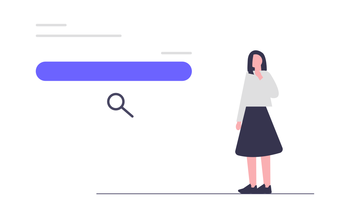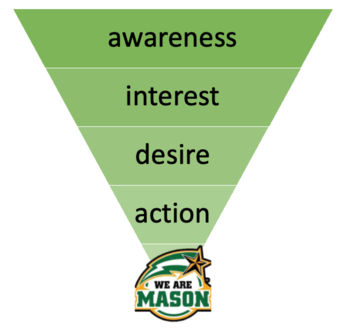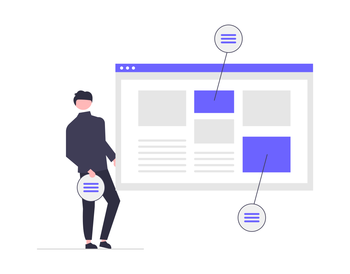You may have heard of the terms "user journeys" and "marketing funnels" before. Both are critical concepts to think about when developing and designing websites. Let's explore these concepts and how they can help you better understand and engage with your website's visitors.
User Journeys
A user journey is the path that a user takes when interacting with a product or service. In the context of college admissions, a user journey might include the steps a student takes from initially researching colleges to submitting an application and ultimately enrolling in a school. Understanding a user's journey through your site allows you to see the user's perspective and tailor your marketing efforts accordingly.
Let's take a closer look at an example of a user journey in college admissions using a hypothetical college and its rocket science program:

The user traveling this journey is Jane. Jane is a high school student seeking to apply for college to earn a degree in rocket science. She wants to know that the university she applies to will have opportunities for her to take part in groundbreaking research. With this goal in mind, she is going to begin her journey by doing research into a variety of colleges.
When Jane stumbles upon our hypothetical college's rocket science program, she will move to investigate, searching specifically for content related to this college. Let's say she finds a landing page for the college's rocket science degree program. This page gives insights on the program, what research is being done on campus, and more. This page may lead Jane to delve into other pages around the college's website, learning more information relevant to her search.
If this site does a good job, Jane may be convinced this program is a good fit for her needs. At this point, she is looking for information on how to apply for the program, such as due dates, requirements, and forms. Presuming her search is successful, she will submit an application to the college. Her search has been successful, and she has achieved her goal.
As marketers, we need to take a look at how each step in this user journey plays out. Like a hiker on a forest trail, there need to be markers and points of interest along the way to keep the user on the correct path. Should they get lost along the way, we risk losing users as they do not achieve their goal. How do we make sure they don't get lost? We need to design our websites and pages with various user journeys in mind.
Marketing Funnels

While user journeys deal with the user's side of things, marketing funnels are how you can think about all the user journeys from a more designer side of things. By combining various user journeys together, we get an idea of the general stages different users might go through on their journeys through our site.
A marketing funnel is a way of visualizing user journeys in stages. The funnel metaphor represents how users will inevitably be lost at each step of the process, with only a percent of those who visit reaching their goal. Keep in mind that not all of this loss is negative. Your user may be looking for something that just does not align with what you are marketing. The goal is to prevent unnecessary loss.
There are many variations of the marketing funnel, depending on your industry and what makes sense for your team. However, for today, we're going to use this one:
| Stage | Meaning | Related Concepts |
| awareness | the user has heard of us | SEO |
| interest | the user wants to know more | content connections |
| desire | the user wants to know the next steps | sitewide navigation, CTAs |
| action | the user is taking steps to be involved | user experience |
| success | the user has completed the goal |
Using the example of Jane from earlier, we can see her in the awareness stage when she is researching which schools have a rocket science program. To capture her in the first stage of the funnel, we would need to make sure our school's website shows up in search results, or that it is well represented on social media. Anything that serves to get the word out there that we exist is a boon to this stage.
As soon as Jane heard of the program, she entered the interest stage as she seeks to learn more about the hypothetical school's specific degree program. In this stage, we are most interested in making sure we present ourselves well on our marketing landing pages, that we have related information easily findable from there, and that we are showcasing as many potential areas of interest as we can (within reason).
Once Jane decides she is interested in applying, she enters the desire stage. At this point, Jane wants specifics on how to apply and what the timeline looks like. Having easy calls to action that point to admissions information will go a long way here.
After Jane starts the application process, she enters the action phase. This step is complicated, as losing users here can be as simple as "their wallet was across the room and they didn't want to get up." However, you can cover your bases by making sure things are as easy to use as possible.
Once the application is completed, Jane is at the success stage. She is what we would call a "conversion" now, someone who has completed the transition from visitor to customer, to use more consumer-minded language.
Utilizing This with Your Sites

By understanding the user journey and the marketing funnel, you can create targeted campaigns that address the needs and concerns of potential users at each stage of the journey. Here are some steps to consider:
- Define user personas: Define user personas based on your target audiences. This will help you understand how users might interact with the website and design journeys that meet everyone's needs.
- Define the goal of your content: Determine the overall goal of your page (or series of pages) and consider the journey your user would take to achieve that goal. What do you want your users to do on each page? What information do you want them to find?
- Map the journey: Lay out the intended journey step-by-step. Make sure the journey is clear and easy to follow, with clear calls to action and visual cues to guide users through the content.
- Analyze user behavior: Take a look at your metrics at every step of the user journey to identify areas for improvement. Using analytics tools, you can track things like where users click and how long they stay on each page. Use this information to make data-driven decisions to optimize the user experience.
- Optimize for mobile: With more and more users accessing websites on mobile devices, it is essential to design user journeys that are optimized for mobile. Make sure the user journey is just as easy to follow on small screens!
Seeking to Learn More?
Check out these related articles!
